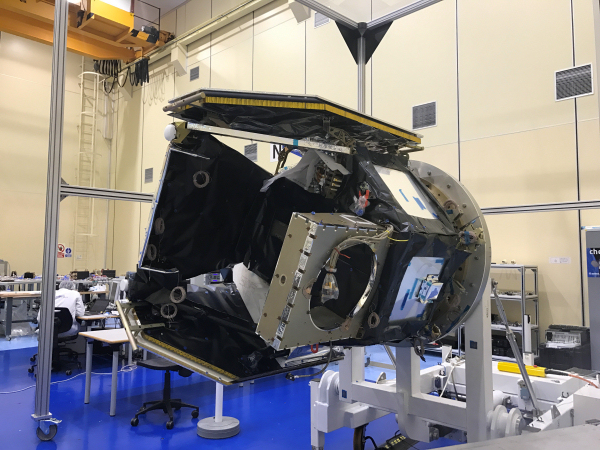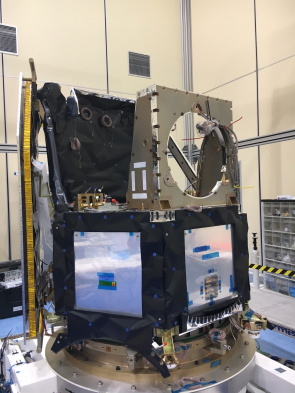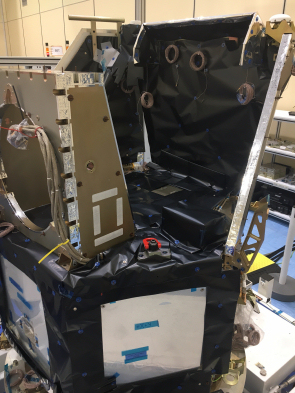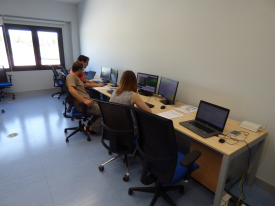#8: Preparing the CHEOPS spacecraft platform and simulating mission operations
12 July 2017
In our previous update, we reported on the delivery of the CHEOPS telescope from Florence to Bern. While the scientific payload is being assembled in Switzerland, work in Spain has focused on preparing the spacecraft platform that will carry the payload and provide power, propulsion, communications, and thermal control. |
| Top view of the CHEOPS spacecraft platform. Credit: ADS–Spain |
After mechanical installation and electrical testing of the individual hardware components, it was important to find out whether the ensemble of hardware units on the platform flight model would behave as required when operated by the attitude and orbital control software. This was successfully demonstrated during the first integrated system tests, when the software control modes were executed using a closed-loop, locally connected set-up. The next step was to validate the remote operation of the platform by issuing commands from a distant location.
In June, the 1.5m × 1.4m × 1.5m spacecraft platform was put through its paces to test the systems responsible for receiving and executing commands from mission control and transmitting science data back to Earth. The tests involved validating the operational procedures that will allow the spacecraft to be controlled in orbit. For example, by operating the propulsion module to manoeuvre the spacecraft.
 |
 |
| Side view of the CHEOPS spacecraft platform. Credit: ADS–Spain | CHEOPS spacecraft platform before integration of the science payload. Credit: ADS–Spain |
The work of testing the command sequences takes place under the responsibility of Airbus Defence and Space (Spain), in a series of System Validation Tests (SVTs). The SVTs progress from tests of the communication interfaces between the spacecraft and mission control (SVT-0), to tests of the spacecraft platform (SVT-1A) and the scientific instrumentation (SVT-1B), to end-to-end testing including the Science Operations Centre (SVT-2), and finally to pre-flight checks following the spacecraft environmental test campaign in Switzerland, France, and the Netherlands (SVT-3).
The second CHEOPS System Validation Test, SVT-1A, took place in Spain between 12 and 16 June. This phase of testing was performed on the spacecraft platform and did not involve the telescope payload, which is still in Bern. Tests of the integrated spacecraft platform and telescope payload will take place during SVT-1B in October.
 |
| Remote operation of the CHEOPS spacecraft. Credit: INTA, Spain |
The Mission Operations Centre (MOC) for CHEOPS will be located at Spain's National Institute for Aerospace Technology (INTA) in Torrejón. From here, MOC operators will transmit instructions and receive data from CHEOPS as it orbits approximately 700 km above the Earth. For the purpose of the system validation tests, the team of MOC operators sent control commands from the MOC to the platform hardware located 35 km away at the Airbus cleanroom in Madrid. This was the first opportunity for the team that will monitor and control the spacecraft in orbit to get together and simulate operational procedures. However, even the best-laid theoretical plans throw up surprises when put into practice, so ironing out practical issues and fine-tuning operational procedures was an important part of the system validation testing.
Another challenging aspect of the tests is simulating in-orbit conditions while the spacecraft is still on the ground. For this, the spacecraft's sensors need to be 'fooled' into reacting as if CHEOPS were travelling in space. This is achieved by offering moving star-map images to the star trackers to simulate changes in orientation, and using a variable magnetic field to simulate the rotating magnetic field as CHEOPS orbits the Earth while compensating for the ground-level magnetic field as measured by the CHEOPS magnetometers.
During the SVT-1A campaign an extensive set of operational sequences has been manually tested using mission control and flight dynamics software developed by the company GMV. The type of operational sequences that are necessary for controlling the spacecraft are, for example, orbital manoeuvres for inserting the spacecraft into the correct orbit after separation from the launcher and for collision avoidance, pointing the telescope, operating thermal control systems, downloading science data, and uploading software patches.
 |
| Screenshot of the spacecraft control system. Credit: ADS/GMV |
Now that SVT-1A has been completed, the spacecraft platform is almost ready for integration with the telescope payload. The information gained from the tests will be used to consolidate and automate some of the operational sequences so that a well-drilled mission control team can safeguard the mission and maximise the scientific yield.
In June, CHEOPS successfully passed the Ground Segment Implementation Review (GS-IR), which is a key milestone within the Ground Segment development. The review focused on the implementation status of operational elements of the Ground Segment, including the Mission Operations Centre and Ground Stations, the Science Operations Centre, the preparation for Launch and Early Operations, and Commissioning Phases, as well as the Guest Observers' Programme. The review also covered the procedures that will be in place to monitor and evaluate the scientific performance of CHEOPS that, in turn, will enable the science objectives of the mission to be met.
The next major review of the Ground Segment will be the Readiness Review, during which the readiness to start operational validation of the operational procedures and the teams that will operate CHEOPS after launch will be assessed. This review is currently foreseen to take place in mid 2018.
About CHEOPS
CHEOPS is an ESA mission implemented in partnership with Switzerland, through the Swiss Space Office (SSO). The University of Bern leads a consortium of 11 ESA Member States contributing to the mission and represented in the CHEOPS Science Team. ESA is the mission architect responsible for overall mission definition and procurement of the spacecraft and launch. ESA is also responsible for early operations phase that will be executed by the spacecraft contractor, EADS CASA Espacio S.L., which is part of Airbus Defence and Space. The science instrument is led by the University of Bern, with important contributions from Austria, Belgium, Germany and Italy. Other contributions to the science instrument, in the form of hardware or science operations, are provided by Hungary and by France, Portugal, Sweden and the United Kingdom respectively. CHEOPS will be launched from Europe's spaceport in Kourou, French Guiana, on a Soyuz rocket operated by Arianespace. Following successful in-orbit commissioning of the spacecraft, responsibility for operations will be taken over by the CHEOPS Mission Consortium, with the Mission Operations Centre under the responsibility of Spain and the Science Operations Centre led by and located at the University of Geneva, Switzerland.





